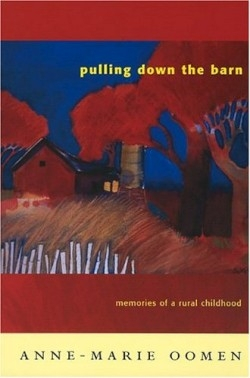Pulling Down the Barn
In this memoir, when the author’s family pull down the barn in 1994, they find a board that dates the structure back a hundred years. The center of her family’s farm, inland from Lake Michigan, the barn is also central to her childhood in the fifties and sixties, its destruction really an epilogue to events that loosened her connection to farming life. To write that epilogue, she must reconstruct the barn and her connection with it from memory.
She begins by trying to recover the sound of her grandmother’s voice: “I am trying to hear hers and the voices of that childhood: the words, the unwords, the other languages, the machines, the fields, the barns and their animals. I am trying to connect again through the inconsistency of memory-a spill of a girl, liquid and wet, soaking into the fabric of that time-longing to know what was being said on that farm.” The book then opens up into a series of vignettes and episodes-riding out to the hayfields, running naked in the rain, jumping deer in a rye field, picking apples and asparagus and washing cherries, swinging on a rope in the barn-all imbued by the author with a vivid immediacy and a restrained reflectiveness.
Oomen’s book fulfills two primary responsibilities of memoir. It serves the writer’s needs, by allowing her to comprehend the inadvertent trajectory of her life, and it serves readers’ needs, by inviting them into the author’s experiences and connecting her life with their own. It also helps stretch our appreciation of the possibilities of the memoir form. Memoirists are often hampered by a mistaken desire to heighten the drama of their memoirs by constructing a smoothly flowing narrative, developing characters and scenes, and providing a conclusive resolution of conflicts-adopting, in other words, the formulas of well-made plays, uplifting novels, and popular films and running the risk of being less honest, less accurate, less factual and more fabricated. Oomen evades all of these pitfalls by fashioning a book that, like our memories themselves, is essentially a series of evocative and revealing vignettes from a rural childhood; its episodes resonate within the reader cumulatively, building as the book progresses.
Oomen, creative writing chair at Interlochen Arts Academy, brings her talents as an actress, performing poet, and playwright to her prose. The interlinked essays read like scenes from a one-woman autobiographical play, a series of reflective reminiscences presented as blackout sketches, an accumulation of gentle epiphanies arrived at in intermittent stages of soliloquy. Most of the moments are brief, quietly told, and carefully nuanced, as when the narrator falls from a rope in the barn and has the breath knocked out of her; despite her mother’s assurances that she hasn’t died (as the child suspects), at that moment she realizes something about the tenuousness of life. This realization is circumspectly reinforced in other segments.
The vignettes are all grounded in commonplace events. The longest essay is set at a Catholic girls’ school in Grand Rapids, where the narrator falls under the spell of a roomful of Madonnas and “The Man from U.N.C.L.E.”, but it puts the excursion into religious calling into perspective by returning to the farm. None of the highly-charged moments-such as when her brother’s bee allergy is discovered after he is stung by the wild bees allowed to build a hive in the walls of the house, or when the narrator loses control of the tractor she’s finally been allowed to drive-never lead to tragic consequences around which so many memoirs are constructed. However, the narrator’s continual reawakening to aspects of life to which she had been oblivious is all the more convincing because it is so universal. If growth and wisdom depended on extraordinary events and heightened drama, most of us would remain simple and unsophisticated all our lives. More than idiosyncratic lives (and memoirs) can, Oomen quietly introduces us to our own lives by introducing us to hers.
She effectively inhabits a child’s voice on the page and her use of present tense throughout creates a heightened sense of immediacy. Though this occasionally complicates reflective sentences that suggest an adult perspective, it is highly effective in recapturing the naïveté and burgeoning understanding of a developing mind. At the heart of this book is a quiet awareness of the subtle and incremental ways a child’s comprehension of the universe expands and alters over time. By interlinking observant, evocative, lyrical essays to form a richly reflective memoir, Oomen deftly and quietly brings these moments of change to life.
Reviewed by
Robert Root
Disclosure: This article is not an endorsement, but a review. The publisher of this book provided free copies of the book to have their book reviewed by a professional reviewer. No fee was paid by the publisher for this review. Foreword Reviews only recommends books that we love. Foreword Magazine, Inc. is disclosing this in accordance with the Federal Trade Commission’s 16 CFR, Part 255.

